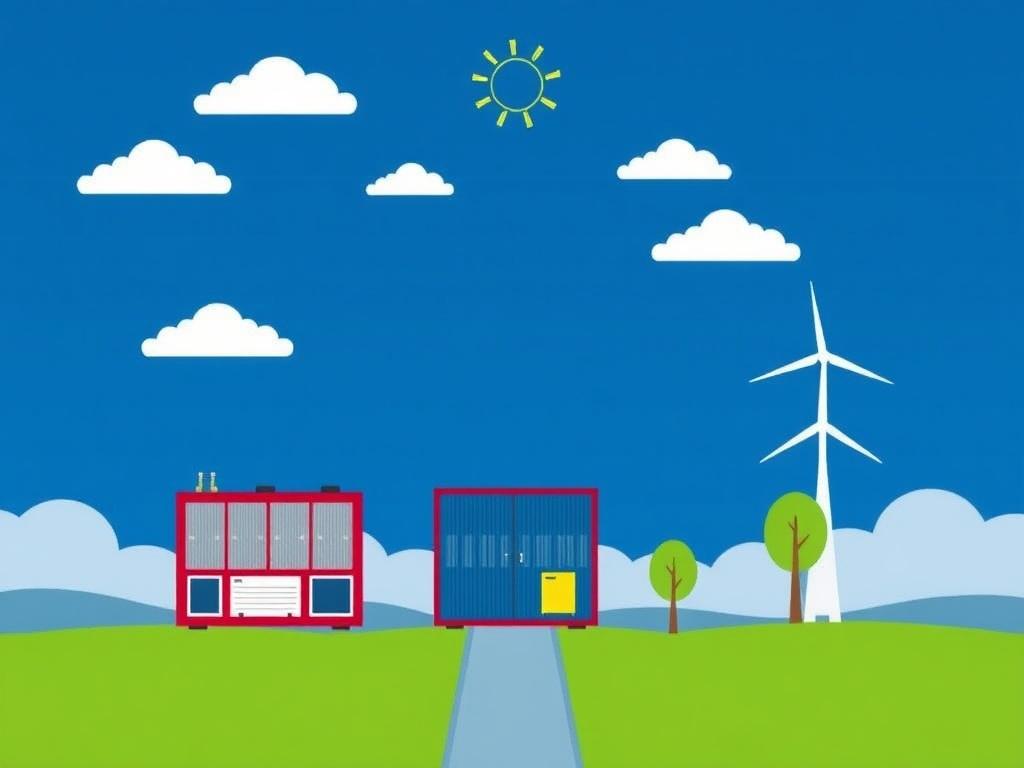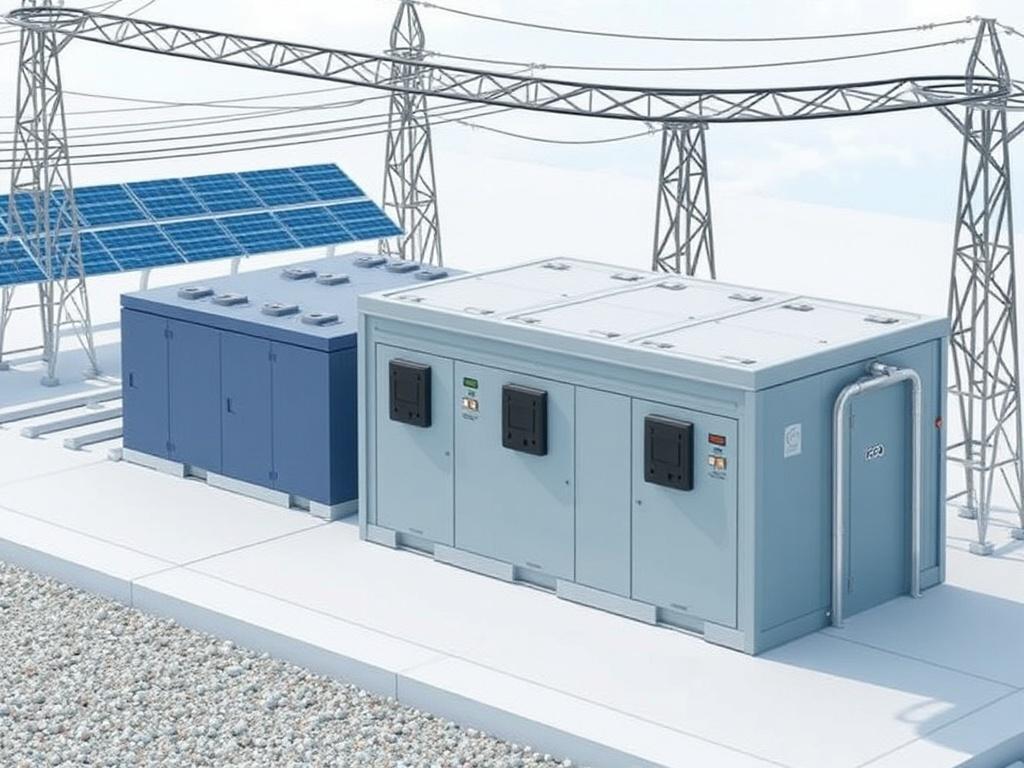- Introduction to Grid-Scale Battery Systems
- What Are Grid-Scale Battery Systems?
- Key Functions of Grid-Scale Battery Systems
- How Do Grid-Scale Battery Systems Work?
- The Basic Workflow
- The Role of Power Electronics
- Electrochemical Technologies Behind Grid-Scale Batteries
- The Growing Importance of Grid-Scale Battery Systems
- Supporting Renewable Energy Transition
- Enhancing Grid Reliability and Resilience
- Reducing Dependence on Fossil Fuels
- Applications and Use Cases of Grid-Scale Battery Systems
- 1. Peak Shaving
- 2. Frequency Regulation
- 3. Renewable Energy Firming
- 4. Microgrid and Islanded Applications
- 5. Emergency Backup and Black Start
- Challenges and Considerations in Deploying Grid-Scale Battery Systems
- High Capital Costs
- Technology Limitations
- Battery Degradation
- Environmental and Resource Concerns
- Grid Integration and Regulatory Hurdles
- The Future of Grid-Scale Battery Systems
- Summary Table: Pros and Cons of Grid-Scale Battery Systems
- Conclusion
Introduction to Grid-Scale Battery Systems

Imagine a world where electricity flows seamlessly, regardless of weather or time of day, powering homes, businesses, and even electric vehicles without interruption. This vision is becoming a reality, thanks in large part to grid-scale battery systems. These massive energy storage solutions have emerged as vital components in modern power grids, helping to balance supply and demand, integrate renewable energy sources, and enhance grid reliability. But how exactly do grid-scale battery systems work? What technologies power them, and why are they becoming increasingly important in our energy landscape?
In this article, we will explore the fascinating world of grid-scale battery systems, explaining their operation in simple terms, the key technologies involved, and their impact on energy infrastructure. We’ll also look at the various applications of these systems and the challenges they face. Whether you’re a curious energy enthusiast or someone interested in how the future of electricity is evolving, read on to discover how grid-scale battery storage is revolutionizing power grids worldwide.
What Are Grid-Scale Battery Systems?
At its core, a grid-scale battery system is a large-capacity energy storage installation connected to the electrical grid. Unlike the small batteries you use to power your phone or laptop, grid-scale batteries are massive and capable of storing megawatt-hours (MWh) of electricity, enough to power thousands of homes for hours or even days.
These systems act as giant reservoirs of energy, storing excess electricity when supply outpaces demand and releasing it back to the grid when demand exceeds supply. This capability makes them essential in managing energy flow, especially as more intermittent renewable sources like solar and wind come online.
Key Functions of Grid-Scale Battery Systems
- Energy Arbitrage: Buying electricity at low cost (often during off-peak hours) and storing it to sell or use during peak demand when prices are higher.
- Grid Stabilization: Providing frequency regulation and voltage support to maintain grid reliability.
- Backup Power: Supplying emergency power during outages or grid failures.
- Renewable Integration: Smoothing out the variable output of renewable energy systems by storing excess power for later use.
How Do Grid-Scale Battery Systems Work?
Understanding how a grid-scale battery system works requires a look at the process of charging, storing, and discharging electricity through advanced electrochemical technologies.
The Basic Workflow
When there is surplus energy on the grid—perhaps due to high wind generation at night or solar power during a sunny afternoon—the system draws electricity to charge the batteries. The chemical reactions within the batteries convert electrical energy into stored energy. Later, when the grid faces high demand or if renewable generation wanes, the batteries discharge, converting stored chemical energy back into electricity that feeds into the grid.
The Role of Power Electronics
Grid-scale battery systems don’t connect directly to the power lines without some processing. Power conversion systems, including inverters and rectifiers, play a crucial role in converting between alternating current (AC) used on power grids and direct current (DC) used inside batteries. Sophisticated control systems ensure smooth operation, monitoring battery health, managing charge and discharge cycles, and responding to grid signals.
Electrochemical Technologies Behind Grid-Scale Batteries
Several types of battery technologies power grid-scale systems, each with unique characteristics influencing performance, cost, and lifespan. Let’s explore the most common technologies:
| Battery Technology | Mechanism | Advantages | Challenges | Typical Uses |
|---|---|---|---|---|
| Lithium-Ion | Electrochemical reactions between lithium ions and electrodes | High energy density, fast charging, long cycle life | Costly, thermal runaway risk, resource concerns | Peak shaving, frequency regulation, renewables integration |
| Flow Batteries | Electrolyte solutions stored in tanks, with energy stored in chemical form | Scalable capacity, long lifespan, safe operation | Lower energy density, larger footprint, higher complexity | Long-duration storage, grid balancing |
| Lead-Acid | Lead plates immersed in sulfuric acid | Low cost, proven technology | Shorter lifespan, environmental concerns, heavy | Backup power, small-scale storage |
| Sodium-Sulfur (NaS) | Molten sulfur and sodium electrodes at high temperature | High energy density, suitable for utility-scale | High operating temperature, safety concerns | Grid storage, load leveling |
The Growing Importance of Grid-Scale Battery Systems
So, why are grid-scale battery systems suddenly grabbing so much attention? The answer lies in the changing nature of our energy systems.
Supporting Renewable Energy Transition
Renewable energy sources such as solar and wind are intermittent: the sun doesn’t always shine, and the wind doesn’t always blow. This intermittency makes managing power supply a challenge for grid operators, who must continuously balance generation and consumption to avoid blackouts or equipment damage.
Grid-scale battery systems mitigate this problem by storing excess renewable energy generated during peak production times and discharging it when renewable sources dwindle. This ability smooths out fluctuations and enables higher penetration of clean energy on the grid.
Enhancing Grid Reliability and Resilience
Modern grids face ever-increasing pressure with growing loads and the integration of distributed energy resources. Grid-scale batteries contribute significantly to grid reliability by providing instant power to stabilize frequency and voltage, helping to avoid outages. Furthermore, they offer resilience against natural disasters and cyberattacks by supplying backup power when traditional sources are compromised.
Reducing Dependence on Fossil Fuels
By providing fast-response energy storage and enabling more renewables, grid-scale battery systems help reduce reliance on fossil fuel-based peaker plants, which are often expensive and polluting. This shift contributes to lowering carbon emissions and promoting sustainable energy futures.
Applications and Use Cases of Grid-Scale Battery Systems

Grid-scale battery systems serve various essential roles across different scenarios. Below are some common applications:
1. Peak Shaving
Electricity demand fluctuates throughout the day, reaching peaks during morning and evening hours. Peak shaving involves batteries discharging power during these peaks, reducing the need to ramp up fossil fuel plants or buy expensive peak electricity.
2. Frequency Regulation
The power grid must maintain a stable frequency, typically around 50 or 60 Hz. Fluctuations in supply or demand can disrupt this balance. Batteries respond instantly to frequency deviations by charging or discharging, helping keep the grid stable.
3. Renewable Energy Firming
When solar or wind output is unpredictable, grid-scale batteries provide a buffer by storing excess generation and supplying power during shortages, ensuring a steady flow to consumers.
4. Microgrid and Islanded Applications
In remote locations or microgrids that operate independently from the main grid, batteries help balance supply and demand, provide backup power, and ensure continuous operation.
5. Emergency Backup and Black Start
During grid outages, battery systems can supply emergency power to critical infrastructure. Some are also designed to help restart power plants and the grid itself after major blackouts.
Challenges and Considerations in Deploying Grid-Scale Battery Systems

Despite their many benefits, grid-scale battery systems face several hurdles:
High Capital Costs
While prices for battery storage have declined rapidly, initial investment remains significant. The cost includes not only batteries but also power conversion equipment, control systems, and site development.
Technology Limitations
Different battery types come with trade-offs in energy density, cycle life, safety, and scalability. Selecting the right technology depends on specific applications and grid needs.
Battery Degradation
Repeated charging and discharging lead to gradual deterioration, reducing storage capacity over time. Managing battery health and lifecycle is critical for cost-effectiveness.
Environmental and Resource Concerns
Some battery chemistries rely on materials like lithium, cobalt, and nickel, which pose environmental and ethical challenges related to mining and disposal. Recycling and alternative technologies are being developed to address these issues.
Grid Integration and Regulatory Hurdles
Integrating battery systems into existing infrastructure requires technical coordination and compliance with regulations, which can vary by region and utility.
The Future of Grid-Scale Battery Systems
The roadmap ahead for grid-scale battery storage is promising. Technological advancements are accelerating, with new chemistries such as solid-state batteries, advanced flow batteries, and metal-air designs under development. These innovations aim to boost energy density, reduce costs, and enhance safety.
Additionally, the rise of electric vehicles and distributed storage resources is expected to create new grid services and market opportunities. Combined with digital technology and artificial intelligence, future grid-scale battery systems will be smarter, more efficient, and more seamlessly integrated into energy ecosystems.
Summary Table: Pros and Cons of Grid-Scale Battery Systems
| Pros | Cons |
|---|---|
|
|
Conclusion
Grid-scale battery systems are rapidly transforming how we generate, store, and manage electricity, playing a foundational role in the global shift toward cleaner, more resilient, and smarter energy grids. By storing vast amounts of energy and releasing it when needed, these systems counterbalance the challenges that come with renewable energy’s intermittency, improve grid stability, and reduce reliance on fossil fuels. Although challenges like cost, technology limitations, and environmental concerns remain, ongoing innovation and increasing deployment are continually driving progress. As battery technologies evolve and become more affordable, grid-scale storage will become an indispensable element in the energy puzzle, helping ensure that electricity is not only sustainable but also reliable and accessible for all. Understanding how grid-scale battery systems work—and their potential impact—enables us to appreciate the remarkable journey toward a cleaner and more resilient energy future.
Как вам статья?







